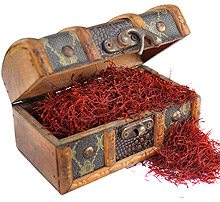Saffron

In foods, saffron is used as a spice, yellow food coloring, and as a flavoring agent. In manufacturing, saffron extracts are used as fragrance in perfumes and as a dye for cloth.
Saffron's aroma is often described by connoisseurs as reminiscent of metallic honey with grassy or hay-like notes, while its taste has also been noted as hay-like and sweet. Saffron also contributes a luminous yellow-orange colouring to foods.
Saffron is widely used in European, Arab, South and Central Asian, Persian, and Turkish cuisines. Confectioneries and liquors also often include saffron. Saffron has a long medicinal history as part of traditional healing; modern medicine has also discovered saffron as having anticarcinogenic (cancer-suppressing), anti-mutagenic (mutation-preventing), immunomodulating, and antioxidant-like properties.
Saffron stigmas, and even petals, have been said to be helpful for depression. Early studies show that saffron may protect the eyes from the direct effects of bright light and retinal stress apart from slowing down macular degeneration and retinitis pigmentosa. Saffron is also used as an aphrodisiac.